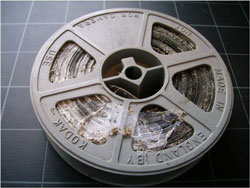Old cinematic films that have been donated to archives such as the British Film Institute have often been stored for decades in attics, cupboards and sheds. These inappropriate storage conditions have led to fungal colonisation on films, resulting in damaged film and the production of spores. Not only is this destroying historical footage, it’s also posing a serious inhalation hazard to archivists that process and inspect the films.

A mouldy film reel © Craig Banks
Craig Banks and his team at Manchester Metropolitan University in the UK have come up with a technique to detect mould on old film to help archivists decide how best to handle it. Using solid-phase micro-extraction coupled with gas chromatography mass spectrometry, the team detected microbial volatile organic compounds (MVOCs) on old cine film. MVOCs are only produced when mould is actively growing. The team analysed sixteen fungal isolates found on the cine film and from these, detected over 150 volatile compounds. Three of the MVOCs (1-octen-3-ol, 3-octanone and 3-octanol) were present in all the fungal isolates tested, so detecting them in particular would indicate that mould is actively growing on the film.
Read the full story here in Chemistry World.
Link to journal article:
Identification of microbial volatile organic compounds (MVOCs) emitted from fungal isolates found on cinematographic film
Gavin D. Bingley, Joanna Verran, Lindsey J. Munro and Craig E. Banks
Anal. Methods, 2012, Advance Article
DOI: 10.1039/C2AY05826J










